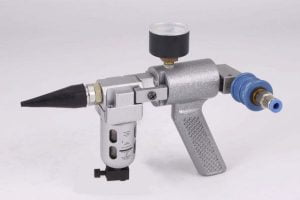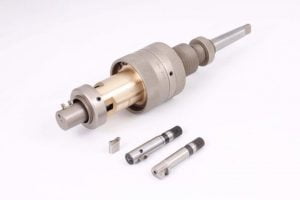Tube Installation Tooling
Table of Contents
Tube Installation Tooling Available - Links Above:
From the links above all of the tube installation tooling can be found:
Major Causes of Tube Leaks
Tube rolling leakage is usually caused by one of the following under rolling, over rolling, improper preparation of tube sheets and differential thermal expansion. Improper expansion can lead to serious difficulties with the manufacturer and the repair serviceman.
Under Rolling
Under rolling as the word would imply is when the tube is not expanded to fill the tube sheet hole and the proper amount of wall reduction is not obtained. It is better to under roll than to over roll.

Over Rolling
Over rolling is when the expansion of the inside diameter of the tube surpasses the expansion required for the proper percentage of wall reduction for the ultimate tube joint. Over rolling can do considerable damage to the tubular vessel. Over rolling will decrease the dimensions of the ligament between tubes and weaken the bridge. Once a ligament is weakened, it will cause a reaction in all ligaments surrounding that weak ligament. If we decrease the strength of the ligament the tube to the tube being rolled will be weak.
Over rolling also causes distortion in tube sheets or drums, such as egg shaped holes. It will also cause diametrical expansion which is the overall increase of the tube sheet or drum. Ove rolling has also been known to cause a tube sheet to bow or warp to the point where the standard length tube could not be used in the vessel until bowing or warpage is returned to normal. This is usually corrected by placing stay rods in the vessel and pulling the tube sheets back to their original position.

Preparation of Tube Sheets
Preparation of tube seats in drums, tube sheets, and headers is as follows:
Tube holes are normally drilled and reamed to approximately 1/32” larger than the nominal outside diameter of the tubes. During this operation, it is extremely important that there are no longitudinal scorings left in the tube seat. In cases where out-of-roundness is extreme, predrilling of the tube is advised. Be certain that the tube hole walls and the grooves in the tube walls are cleaned down to bare metal before the tubes are inserted. Be certain all foreign material such as oil, grease rust or just plain dirt is removed. Special attention during this cleaning will prevent serious trouble later.
After tube holes have been prepared they are usually coated with a rust preventative compound. Before inserting any tube, it is important to remove all traces of this coating. It is extremely important that great care be taken in handling the tubes for insertion in all of the vessels discussed above. Be certain that the tube ends are clear of any foreign material. Be especially certain that there are no chips on the tubing which may gouge the tube sheet or tube seat when the tube is placed in the vessel.
In some cases, it will be necessary to force a tube into a tube hole. This should be done with extreme care. It is better to spring the tube than to try to force it with a hammer. If a tube end is kinked or damaged before rolling, the expanded end will be damaged, and a leaky roll joint will result. Attention at this time to the tube ends and the tube alignment will prevent future troubles.

Improper Preparation of Tube Holes
Improper preparation of tube holes is another major cause in tube leakage. If the tube sheet or drum is gouged, it is extremely hard to expand the tube to fill these gouges or tears without over-rolling. The smoother the tube seat or tube hole the easier it is to roll an optimum tube joint. The ligaments and light tube walls make it more important that the finish of the tube hole be in the low micro range. We find many manufacturers today are drilling, reaming and sizing or burnishing to get the micro finish desired for tube holes.
Preparation of Tube Holes
The preparation of tube holes in heat exchangers and condensers is as follows. Drill and ream tube sheet holes to .007” to .010” over the outside diameter of the tube to be used. Be certain the ligaments are enough to guarantee a safe and permanent tube joint. When conditions permit, utilize a sizing or burnishing tool to further assure a good finish in the tube hole. This will also increase the tensile strength of the ligament. The serrations or grooves to be used will determine the holding power of the tube. It is extremely important when retubing that the grooves be cleared of all metals or any foreign material.
